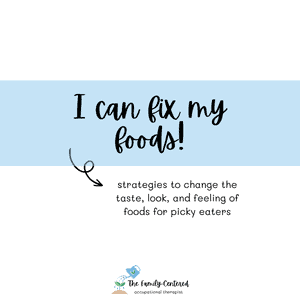But my child won't eat veggies otherwise!
When you have a child with restricted or picky eating habits, it causes a lot of stress. Caregivers worry whether their children are getting adequate nutrition in order to grow and stay healthy. Sometimes, this causes us to use rewards, such as earning dessert or getting a preferred food by trying or eating a non-preferred food (like a veggie). This can be effective in the short-term, but unfortunately has negative long-term effects.
Decreased trust and sense of safety
For kids with truly restricted eating patterns, non-preferred or unfamiliar foods are perceived in their bodies as a threat. Their adrenaline increases and they go into “fight or flight” mode. While we are not “forcing” our kids to eat by using contingencies, children understand the underlying message. Just as you might have difficulty trusting me if I teach you to ignore the snarling snake in the corner, your child might have difficulty trusting if they realize that their success relies on eating the threatening food.
Ellen Satter suggests that it is, in fact, not our job as parents to get our child to eat. She describes a division of responsibility where the parent determines what is available, when it is available, and where it is available. But it is the child’s job to eat. Learn more about her division of responsibility in feeding here.
Not listening to body signals
We want children to learn to read their own body signals and pay attention to them, so they can adjust things appropriately. For example, when their stomach rumbles, we want them to know it’s time to eat. Or when their stomach starts to feel full, they should stop eating.
When restricted eaters see a new or non-preferred food, it is perceived as a threat. If we ask them to eat it anyway in order to earn the dessert they so badly want, they have to stop listening to that anxiety. And maybe that works in the moment, but do we really want our children to ignore their anxiety long-term? What about when there is a “true” threat, such as a harmful person?
Teaching children to ignore their body signals is akin to teaching them to accept harm, even if we know that the food won’t directly harm them. Eventually, teaching children to ignore bodily signals can lead to disordered eating, a lack of self-awareness, and difficulties with self-regulation. In fact, there is a body of literature that suggests that eating disorders are correlated to a lack of awareness of a person’s internal body signals.1
Reduced motivation to try new things
When your child eats a food because they are earning dessert or their favorite snack, they learn to value the preferred or dessert food more than the food they are learning about. When they are on their own and there is no dessert reward, we want them to still want to learn about the new food, instead of skipping out on it.
So, what do I do instead?
Teach them to fix their foods!
I rarely eat plain, raw vegetables, so why would I expect my kids to eat their veggies plain? Teach your child how the taste of broccoli changes when roasted, air fried, and raw. It might change when it’s dipped in ranch. Maybe your child likes peanut butter. Sure, I don’t typically see people dipping their broccoli in peanut butter, but there’s no rules against it! This empowers them to later change new foods to work better for their bodies on their own.
If you’re confused about what this might look like, check out the 3-page guide to fixing foods below.
Offer all foods together - including dessert!
To prevent foods from being on a pedestal, we can offer all foods together, with a small serving of dessert along with it. Yes, your child might eat dessert first – that’s okay. They will then go on to eat the other “safe” foods on their plate. If they’re not ready to eat something, they can still learn about it by playing with it, exploring how it looks, feels, and smells.




1 thought on “Why I don’t require kids to eat their veggies first (and why dessert goes with our meals)”
Comments are closed.